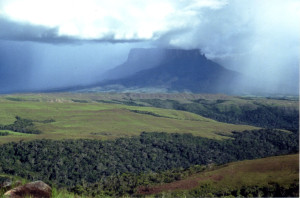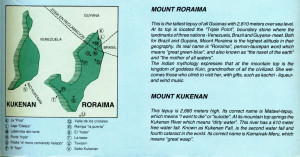About 200 miles away from Jonestown as the crow flies, right near the place where Guyana, Venezuela and Brazil meet, is the site of a mass suicide that occurred some 135 years earlier. Although information abut the suicides remains vague information – including its exact date, described now as late 1843 or 1844 – about the suicide, there is enough evidence from a few sources, most notably the book The Marches of El Dorado by Michael Swan published in 1958, to give credence to the event itself. Sadly, Mr. Swan died of an overdose of booze and sleeping pills in 1967.
Maps of the area show a mountain known by its original name – that is, its name before 1843 – as “Kukenan,” also spelled as “Kukenam” and “Cuquenan,” a Pemon indigenous word meaning “dirty water.” The fourth tallest waterfall in the world plunges from the side of this gigantic fortress
The mountain Kukenan had never been climbed by humans since its sheer cliff-like walls rise vertically 4000 feet above the elevated plain. Man first arrived on top by helicopter in 1963. Therefore, it was unheard of for any human to be at the summit and to jump to his death in 1843, so the name “Matawi Tepuy” or “Suicide Mountain” was named after the mass suicide that took place at the base of this natural fortress.
Michael Swan, the author of The Marches of El Dorado, was a very knowledgeable English man who traveled throughout Guyana and parts of Venezuela and Brazil in the mid 1950s, when Guyana was still a colony of Britain. He intimates that few others have been to some of the areas of his adventures, but that is not exactly accurate since Europeans had explored the areas hundreds of years before. Even though the areas are very remote, they have been traversed and explored.
The account of the death at Suicide Mountain, which have many similarities to the tragedy at Jonestown, with my explanatory annotations in parentheses:
The amazing story of Awakaipu is well documented. He was an Arekuna Indian who had lived for some time in Georgetown and learnt English. The Schomburgks recognized his usefulness and employed him on their expeditions. (Richard and Robert Schomburgk were brothers born in Germany, explorers, and scientists hired by the Royal Geographic Society in London. Richard Schomburgk speaks in admiration of the way he (Awakaipu) behaved when attacked by pirai (piranha fish). Biting his lips with the raging agony, he rolled about in the sand; yet no tears flowed from his eyes, no cry passed his lips. From the tone of Schomburgk’s remarks about him, he seems to have kept his true nature from his employers.
After the Schomburgks had left the colony (of Guyana, and returned to Europe), Awakaipu, still only 25 was seized by a folie de grandeur and wished to make himself chief of all the Indian tribes of British Guyana. He sent messengers throughout the Indian country saying that all who wished to see wonderful happenings, and to know the way to become as rich and powerful as the white men should meet at the beginning of the dry season in the valley of the Kukenam at the foot of mount Roraima. All who came, he said, must forget their quarrels and bring presents, for which they would receive magical presents in return.

Graphics provided by Paul Bolcik
A thousand Indians from every tribe gathered at the foot of the mountain and gave Awakaipu knives, powder (gun powder), shot and fish-hooks. In return he gave them pages from the London Times newspaper. (While the Indians of the interior had all the trade goods of the white man, they had never seen newspaper! Richard Schomburgk had used copies of the London Times for pressing his gathered plants and wild flowers. Awakaipu had gathered up the stack of newspaper that Richard Schomburgk left behind after the brothers left Georgetown and returned to Europe.)
Awakaipu named his new settlement (in the valley of Kukenam) Bekeranta, which is an Indian form of a Dutch-Creole word meaning Land of the White People. He built a two-storied hut, living on the upper floor himself and installing a harem of chosen girls on the floor below. He enhanced his mystery by rarely mixing with the gathered Indians, and when he addressed them, he swathed himself in magical ritual garments so that only his eyes were seen through the folds. On these occasions he threatened death to anyone who did not obey him implicitly. He encouraged cassiri drinking (cassiri is the toxic leftover liquid, extracted from the cassava plant, a food staple of the South American indigenous people), bouts and dancing, hoping that this would induce a state of mind in which all would accept his leadership.
Later he decided that he would have to kill all untrustworthy elements so that the others would follow him. On the night of a general orgy, he appeared and announced through the folds of his gown that he had just been received an audience by the great spirit Makunaima, who had told him that the Indians must never be driven out of their own land by the white people. They must become greater and more powerful than the whites; they must have white women as wives, and themselves have white skins. Makunaima, he went on, had told him that all gathered at Bekeranta could have white skins. They would have to kill each other and their souls would rise to the summit of Roraima, where they would be reborn and return to the valley of Kukenam in two days; their skins would be white and they would have all the knowledge of the white people. And they would be the rulers of all the Indians.Awakaipu had touched the deep-rooted and still surviving skin color envy of the Indian; they heard him with terror. Awakaipu seized a war-club, attacked a man and smashed his head open so that the blood spurted into a gourd of cassiri, which he then drank. The drunken Indians now began to fight each other, and submerged hatreds erupted once again. It is said that four hundred men, women and children were killed during that night of massacre, and the survivors waited day after day to see the resurrected come down from Roraima. When two weeks had passed, there were murmurings against Awakaipu, who seems to have had sufficient belief in his intimations from Makunaima not to leave the valley. Food was now running out and there was hunger in the camp.
Eventually it was realized that there would be no resurrection, and a party of Indians went to the two-storeyed hut of Awakaipu and beat him to death with their clubs.
It is a strange, inconclusive story, with no indication of the real state of Awakaipu’s mind. I have no doubt of the substantial truth of the incident. Decades later, travelers in the region who knew nothing of the massacre found small portions of the London Times in Indian huts, being used as amulets – much as Christians might treasure a splinter from the True cross.
Even though Swan’s book does not mention any sources directly related to this tragedy, he does include a list of sources at the end of his book, which notes works published by the Schomburgk brothers.
A similar strange relation to Jonestown takes the form of Shadows Move Among Them, a novel published in 1951 by Edgar Mittelholzer, an Englishman living in Guyana. In the novel, a difficult figure known as Reverend Harmston, tries to establish a religious community named “Berkelhoost” in the interior jungles of Guyana. The story that follows has a vague uncanny resemblance to real life at Jonestown. A writer of many novels with eerie themes, Mittelholzer took his own life in May 1965.
To learn more on the area of the Awakaipu mass suicide, see ““Through Brazil to the Summit of Mount Roraima,” National Geographic, November 1930, and “Tepuis Venezuela’s Islands in Time,” National Geographic, May 1989.
(Paul Bolcik did more investigation of the sources listed in the selected bibliography of Michael Swan’s 1958 The Marches of El Dorado. The original account of the mass suicide came from the 1871 German book Unter den Tropen by Carl F. Appun (Jena Publishing). Appun obtained the story of the mass suicide from an Arekuna Indian who was the son of one of the men who clubbed Awakaipu to death after the resurrection failed to happen. The Indian told Carl that the suicide happened 24 years before, which would date the mass suicide to the years around 1843 to 1845. Mr. Appun died in 1872 in his return to Guyana at the Mazaruni River Penal Prison, about halfway from Kukenan and halfway to Jonestown. Believing that he was about to be eaten by his Native American guides, he swallowed poison, whereupon his guides took him to the nearest civilizzation, puzzled, no doubt, about what he had done. He died in agony two days later.
(Paul believes that the terms “wacky” and “whacked out” may have entered English slang after the mid-1840s mass suicide. His view is that the Awakaipu – the leader of the mass suicide – could have been pronounced “Whacky-pu,” although more research is needed.
(Paul lives in Rockville, Maryland. He has operated a landscaping outfit since 1988. In his off seasons he has bicycled across 23 countries and through parts of others in Europe, Asia, and North, Central and South America. He is the assistant to the director of the Juan Santamaria historical museum in Alajuela, Costa Rica. His cousin, Chris Bolcik is co-owner of the row house that was once owned by Congressman Leo Ryan in Washington D.C. He may be reached at goldrush_20849@yahoo.com.)
